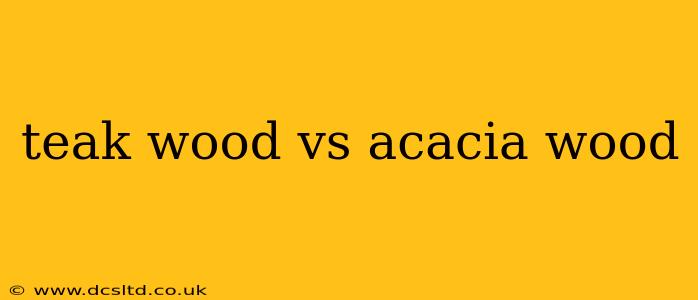Choosing the right wood for your furniture, decking, or other projects can be a daunting task. Two popular choices often top the list: teak and acacia. Both are known for their durability and beauty, but they possess distinct characteristics that make them suitable for different applications. This comprehensive guide will delve into the key differences between teak wood and acacia wood, helping you make an informed decision.
What is Teak Wood?
Teak ( Tectona grandis) is a tropical hardwood prized for its exceptional durability, water resistance, and rich golden-brown color. Its natural oils and high density make it highly resistant to rot, decay, and insect infestation, making it an ideal choice for outdoor applications. Over time, teak weathers to a beautiful silvery-gray patina, adding to its unique charm.
What is Acacia Wood?
Acacia (Acacia genus) encompasses a wide variety of hardwood species, each with slightly varying properties. While not as consistently high-performing as teak, many acacia varieties offer excellent durability and are significantly more affordable. The color can vary greatly depending on the specific species, ranging from light browns to dark reddish hues.
Teak Wood vs. Acacia Wood: Key Differences
Here's a detailed comparison of the two woods across several crucial aspects:
Durability and Longevity
Teak: Renowned for its exceptional durability. Its high oil content and dense grain make it extremely resistant to rot, decay, warping, and insect damage, leading to a significantly longer lifespan, especially in outdoor settings.
Acacia: Offers good durability, though not quite as exceptional as teak. Its performance varies depending on the specific species and treatment. While generally resistant to decay, it may require more maintenance than teak to maintain its appearance and longevity.
Water Resistance
Teak: Naturally highly water-resistant due to its high oil content. It's an excellent choice for outdoor furniture, decking, and boat building where exposure to moisture is inevitable.
Acacia: Possesses decent water resistance, but less than teak. While it can withstand moisture to a degree, it's more susceptible to damage from prolonged exposure to water and requires proper sealing and maintenance for outdoor use.
Price
Teak: Generally more expensive than acacia due to its superior properties, slower growth rate, and sustainable harvesting challenges.
Acacia: Significantly more affordable, making it a budget-friendly alternative for many projects. Its lower cost often makes it a more accessible option for larger projects.
Maintenance
Teak: Requires minimal maintenance, especially if left to weather naturally to its silvery-gray patina. Occasional cleaning is usually sufficient. If you prefer to retain its original golden color, applying teak oil periodically is recommended.
Acacia: Requires more regular maintenance, particularly for outdoor applications. It often benefits from periodic sealing or oiling to protect it from moisture and UV damage.
Appearance
Teak: Characterized by its rich, golden-brown color that weathers to a beautiful silvery-gray. It has a distinct grain pattern that adds to its aesthetic appeal.
Acacia: Color can vary widely depending on the species. Generally features a straight grain, although some species may exhibit more pronounced figuring.
Sustainability
Teak: Sustainable teak sourcing is crucial. Look for certifications from organizations like the Forest Stewardship Council (FSC) to ensure responsible forestry practices. Overharvesting has led to concerns about the sustainability of teak, so responsible sourcing is paramount.
Acacia: Many acacia species are considered fast-growing and relatively sustainable, making them a more readily available alternative. However, it's still vital to choose suppliers committed to sustainable forestry.
What is the best wood for outdoor furniture?
The best wood for outdoor furniture depends on your budget and maintenance preferences. Teak’s superior durability and water resistance make it the top choice for longevity with minimal upkeep, but its higher cost is a factor. Acacia provides a more budget-friendly alternative, but requires more diligent maintenance to withstand the elements.
Is acacia wood durable?
Acacia wood's durability is good, not exceptional. It's resistant to decay and insects to a degree, but not as much as teak. Its performance varies considerably depending on the species and treatment it receives.
Is acacia wood good for outdoor use?
Acacia wood is suitable for outdoor use with proper treatment. It needs regular sealing or oiling to protect it from moisture and UV damage. Without proper care, its lifespan outdoors will be considerably shorter than teak.
Which wood is harder, teak or acacia?
While both are hardwoods, teak generally has a higher Janka hardness rating than most acacia species, indicating greater resistance to dents and scratches. However, the specific hardness of acacia varies considerably depending on the species.
In conclusion, both teak and acacia wood offer valuable qualities for various applications. The optimal choice depends on your specific needs, budget, and desired level of maintenance. Carefully weigh the pros and cons of each wood before making your decision. Remember to always source your wood from reputable suppliers committed to sustainable forestry practices.
